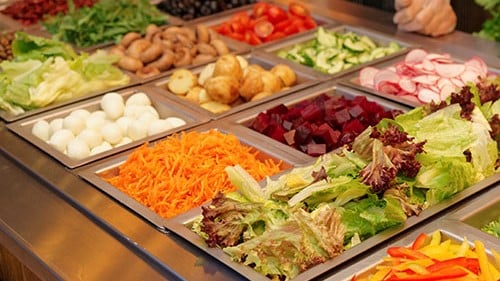At a glance
Behavioral design strategies can be used in food service to facilitate selection of healthier foods. There are several steps to implementing behavioral design in cafeterias, micro markets, vending machines. These strategies can be adapted in other venues such as food kiosks, concession stands, snack bars, sundry shops, and eldercare facilities.

Introduction
Follow the steps below to implement behavioral design strategies in cafeterias, micro markets, and similar venues. Behavioral design can also be applied to vending machines.
Experiment with behavioral design in food service venues. Try different strategies and different combinations of strategies. Consider ways to modify the examples provided for specific venues.
Steps to using behavioral design strategies
- Identify all food service operations in your building, company, or institution. Examples include cafeterias, micro markets, and vending machines, as well as areas where food is prepared or eaten, such as breakrooms.
- Use these checklists to see examples of strategies. Most individual strategies on the checklists include links to visual examples.
- Click on links below for figures illustrating strategies in specific venues. You can adapt these strategies to different venues as appropriate. For example, micro market strategies can be used in food kiosks, concession stands, snack bars, or sundry shops. Similarly, some cafeteria strategies can be used in congregate meal settings, such as in eldercare facilities.
- Deli station of cafeteria.
- Grill station of cafeteria.
- Salad bar station of cafeteria.
- World cuisine station of cafeteria.
- Cafeteria seating and atmospherics.
- Micro market.
- Vending machine for beverages.
- Vending machine for food.
- Deli station of cafeteria.
- Consult or form a committee to focus on behavioral design strategies. If your organization already has a team implementing and managing food service guidelines, recruiting committee members may be an ideal starting point. This team may include public health employees, worksite wellness staff, facility managers and leaders, and food service staff. Using the appropriate checklist, the committee can meet at the relevant venue to:
- Determine which behavioral design strategies are already in use.
- Identify new behavioral design strategies to begin using now or use in the future.
- Compare the benefits of the new strategies with the effort and resources that will be needed to implement them. Depending on capacity, it may be beneficial to begin with the easiest strategies.
- Determine which behavioral design strategies are already in use.
- Use multiple strategies that complement each other to accomplish goals. For example, customers may buy more fresh fruit if you:
- Place healthier items in the line of sight when customers enter the venue (placement and layout).
- Offer fresh-cut fruit in ready-to-eat containers (product innovations and defaults).
- Offer discounts on items that are about to expire. For example, set the checkout machine to charge 50 cents less on Fridays for fruit that will be replaced over the weekend (pricing and promotion).
- Label food products that are locally sourced, certified organic, or produced through other certified community development or environmentally beneficial practice at the point of purchase (information).
- Place healthier items in the line of sight when customers enter the venue (placement and layout).
- Plan to continually introduce new strategies and new combinations of strategies. Monitor your efforts and outcomes and make necessary changes improve the sale of healthy items. This approach will keep the consumer experience fresh. People adapt to changes, and the effectiveness of some behavioral design strategies or combinations may fade over time.
- Make behavioral design strategies part of your ongoing monitoring and evaluation process. For guidance on how to evaluate your food service operations, see the Monitor and Evaluate section of the Food Service Guidelines Implementation Toolkit.
MyPlate for professionals
More behavioral design information
Next steps
Return to "Building Blocks"
Use the "Building Blocks of Food Service Guidelines" to navigate to other parts of the Food Service Guidelines Implementation Toolkit.





